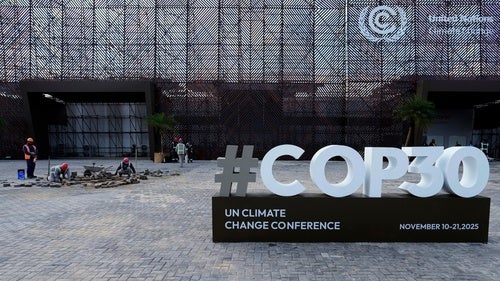Can COP30 Deliver amid US Retreat from Climate Action?

With global emissions still rising and political will waning, what can come out of this year’s international climate negotiations?
Beginning next week, tens of thousands of delegates and observers will descend upon the small Brazilian city of Belém for the 30th meeting of the parties to the 1992 United Nations Framework Convention on Climate Change.
This year’s Conference of Parties (or COP for short) will put climate change back in the spotlight at a difficult moment in international relations. In the face of the Trump administration’s implacable opposition to anything climate-related, what can we expect to see coming out of COP30?
I have modest expectations. International negotiations have produced little since the breakthrough Paris Agreement was negotiated in 2015. The most important work today is in national implementation of climate action. Yes, there have been somewhat fruitful deliberations to compensate countries for loss and damage from climate change, and there were discussions about esoteric topics like carbon trading, but the rules of the road are mostly set.
This waning relevance of international negotiations hasn’t sunk in with advocates or journalists. Since the COVID-19 pandemic, COPs have been massive, even in difficult-to-reach places. More than 85,000 people attended COP28 in Dubai, and more than 50,000 were in Azerbaijan for COP29. It isn’t clear if either of these gatherings produced enough breakthroughs to warrant all the travel.
With emissions trajectories globally still way off track, global climate negotiations could become “zombie” processes—people may still go, but the meetings might become for show, with little substantive coming out of them.
"With emissions trajectories globally still way off track, global climate negotiations could become 'zombie' processes—people may still go, but the meetings might become for show, with little substantive coming out of them."
This jaundiced view might be a distinctly American perspective, based on the headwinds that climate advocates are facing here in the United States. In addition to dismantling internal initiatives, the Trump administration is trying to coerce foreign nations to abandon their own climate and clean energy ambitions. Already, they have successfully delayed a decision on shipping emissions at the International Maritime Organization and have pressured countries to buy more gas from the United States. It is an open question whether those efforts will ultimately succeed.
Meanwhile, China is exporting billions of dollars every month in affordable clean energy technologies like solar, batteries, and electric vehicles around the world, alongside billions of dollars in foreign direct investment in countries for raw materials to support China’s clean tech industries and manufacturing of clean technologies in other countries.
To be fair, the upcoming climate negotiations have prompted some action from major emitters. The Paris Agreement adopted during COP21 is based on Nationally Determined Contributions (NDCs), which are pledges of intent countries make to reduce emissions. NDCs are meant to be updated every five years, with 2025 being a year when countries are expected to update their commitments. Technically due in February, most countries missed the deadline and have been issuing them later.
While the NDCs have been underwhelming overall, China did update its commitment in September, pledging to reduce its emissions by 7 to 10 percent below its peak before 2035. Though that pledge is well below what is needed, it is the first time China has produced a quantitative target to reduce its emissions.
Brazil as host is also trying to drum up financial support for forest conservation through a Tropical Forests Forever Facility. With forests serving as important carbon sinks, if Brazil’s President Luiz Inácio Lula da Silva can raise a fraction of the intended $125 billion, this would be a major achievement.
The Trump administration has already said it is pulling out of the Paris Agreement again, an action that will formally take effect in January 2026. While the United States is still party to the 1992 Framework Convention, the administration also announced it won’t send any high-level representatives to Brazil. This might be a blessing since any Trump administration presence would likely be disruptive.
During the first Trump administration, civil society and subnational actors from the United States took on a defiant tone after President Trump announced the United States would leave the Paris Agreement. The “We Are Still In” coalition hosted side events proclaiming the readiness of other American actors to rejoin the climate fight. The mood among American advocates this time around, however, is more subdued, particularly in light of the administration’s aggressive efforts to crush clean energy technologies at home.
For supporters of climate action, the hope is that clean energy has global momentum that can survive the current difficult politics. Renewables and battery storage are increasingly the most cost-effective, easy-to-deploy energy systems, and electric vehicles are becoming increasingly affordable. Whatever happens in Brazil, that is the real story to keep an eye on.


